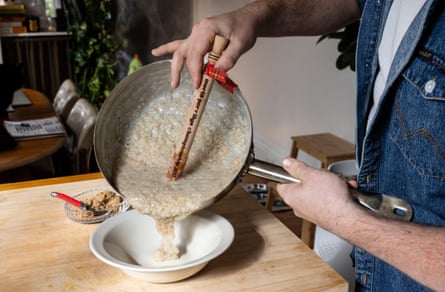Toby Wilson has not one spurtle, but five. His collection of the traditional Scottish porridge-making implements includes one sourced from a museum gift shop, another made by a friend’s mother, while the rest – his most prized – are from his time as a finalist in the 2022 world porridge-making championships.
“As a contestant I got a special one that’s branded with fire,” says Wilson, who was the only Australian to make the top six in the competition that year. “In a world of whatever the fuck is going on, it’s pretty nice to think of being in a tiny village in Scotland on a river, cooking some old-fashioned oats.”

This year, the world porridge-making championships will celebrate its 30th birthday. Held in Carrbridge in the Scottish Highlands, the competition is at once cut-throat and humble, earnest yet self-aware.
Competitors arrive from all over the globe for an opening parade through town and a performance from local primary school students (they sing a song about oats). Contestants, for their part, “are having a good time and having a laugh … but at the same time, are super-focused and everyone works super hard on trying to take home the golden spurtle,” says Wilson.
To train, the Sydney chef made countless bowls of porridge in strict adherence to the competition rules: no milk, rolled oats or accoutrements are permitted in the “traditional porridge” category – only water, untreated oatmeal and salt. This regimen – and eating the results – transformed Wilson from mere oataphile to porridge purist.
“My porridge palate developed a new kind of nuance,” he says. “I oscillated between: ‘This is so boring’, and then having these little aha moments of: ‘Oh my god, it’s like the best bowl of porridge I’ve ever had.’”
But a winning bowl of oats requires neither a Highland village nor a spurtle. Wilson says anyone can make porridge like the champions do.
The ingredients
Put away the rolled oats and quick-cook oats. “They’re just so much flatter in flavour,” says Wilson.
Wilson uses whole-oat groats (the hulled kernels of the oat grain) and stone-grinds them on his commercial mill (designed to wet-mill nixtamalised maize for tortillas, and purchased as a kitchen toy for his day job running his taco eatery Ricos Tacos).

For mill-less souls, store-bought steel-cut oats are a good alternative (and famously, the favourite of former New South Wales premier Bob Carr). They take longer to cook than rolled oats, but an overnight soak will speed things up. “You can still have your breakfast in 10 minutes,” says Wilson. “It won’t be 30 seconds, but it’ll be quick and … much better.”
For the competition, Wilson used “Scottish mineral water from the mountains”, but filtered water will do. “Tap water can mute some of the flavour, but also it’s not a huge deal.”
And always add salt. As with all foods sweet or savoury, salt brings flavour and dimension. With just three ingredients it’s critical. “The porridge [is] the show itself, not a vehicle for bananas, nuts, berries, honey, all that kind of stuff.”
For a one-person serve, Wilson adds about a teaspoon of salt. “I like it like pretty salty … the flavour of going for a run and the sweat falls into your mouth.”
The method
The golden ratio is one part oats to three parts water. For all his exacting methods, Wilson happily plays it loose on measuring vessels. “I use whatever I can find. A teacup? Cool. It’s a teacup of oats to three teacups of water.”

He throws all the ingredients – oats, water, salt – into the saucepan at once over a medium-high heat on the stovetop. “A lot of people think that if you throw salt in too early, the oats don’t cook properly, which is untrue,” he says.
When the mixture reaches a high simmer, he lowers the temperature to a “gentle blip” so the bubbles just break the surface. Then he gently stirs the porridge with a spurtle, though he says a wooden spoon works just as well. Purists stir clockwise “to keep away the bad spirits”, he says. (Whether spirits require anti-clockwise motions south of the equator is a theory he’s yet to test.)
The texture
The oats should be al dente – cooked through, with a slight bite. Sometimes the porridge mixture can thicken too much before the oats are properly plump and hydrated, so add extra water as needed, says Wilson. This process should take between 10 and 15 minutes.
From there, the texture is a matter of personal preference. “Some people like it soupy,” says Wilson, while others prefer to tip their bowl upside down “and the porridge doesn’t fall out”.

To serve
Wilson likes to top his porridge with a pat of butter and a sprinkle of brown sugar. “It’s creamy and salty and buttery and chewy – all the nice things,” he says.
If you are used to the flavour of milk in porridge, he suggests having a small bowl of cold cream on the side. Then dip your warm porridge in, spoonful by spoonful, for a pleasing hot-cold contrast.
"oat" - Google News
June 06, 2023 at 10:00PM
https://ift.tt/UKtGrDh
No milk, no rolled oats and always add salt: how to make porridge like a champion - The Guardian
"oat" - Google News
https://ift.tt/Ne8Euna
https://ift.tt/f0oPYNw
Bagikan Berita Ini














0 Response to "No milk, no rolled oats and always add salt: how to make porridge like a champion - The Guardian"
Post a Comment